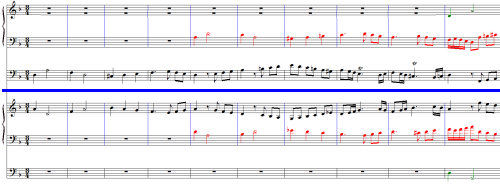Introduction
“Über dieser Fuge…”
Structure of The Art of Fugue
The “unfinished” fugue
About the realization
How to listen to The Art of Fugue
About the narratives
The Art of Fugue
Simple Fugues
Contrapunctus I
Contrapunctus II
Contrapunctus III
Contrapunctus IV
Stretto Fugues
Contrapunctus V
Contrapunctus VI
Contrapunctus VII
Double and Triple Fugues
Contrapunctus VIII
Contrapunctus IX
Contrapunctus X
Contrapunctus XI
Mirror Fugues
Contrapunctus XII + inversus
Contrapunctus XIII + inversus
Quadruple Fugue
Contrapunctus XIV
Here’s the first of AOF’s mirror fugues. These are among AOF’s most engaging and enjoyable music, and the fact that Bach achieved such an effect within the constraints of the severest technical rigor is amazing.
When you play the clip above, you will hear two fugues or, more correctly, the same fugue twice. In the graphic below, I’ll show you both the start of the fugue, and its mirror.

The measures above the blue line are what you’ll hear at the start of the audio. The measures below the blue line begin the mirror fugue, at 1:47. As you can see from the graphic, this is exactly the same fugue, except everything is perfectly inverted. All parts are turned upside down with the intervals preserved. Moreover, the parts are switched…the bass from the first fugue becomes the soprano in the mirror, tenor becomes alto, alto becomes tenor, soprano becomes bass. It’s as if you took the top part of the graphic and flipped it over the blue line, and a whole new fugue results. Astounding, eh?
